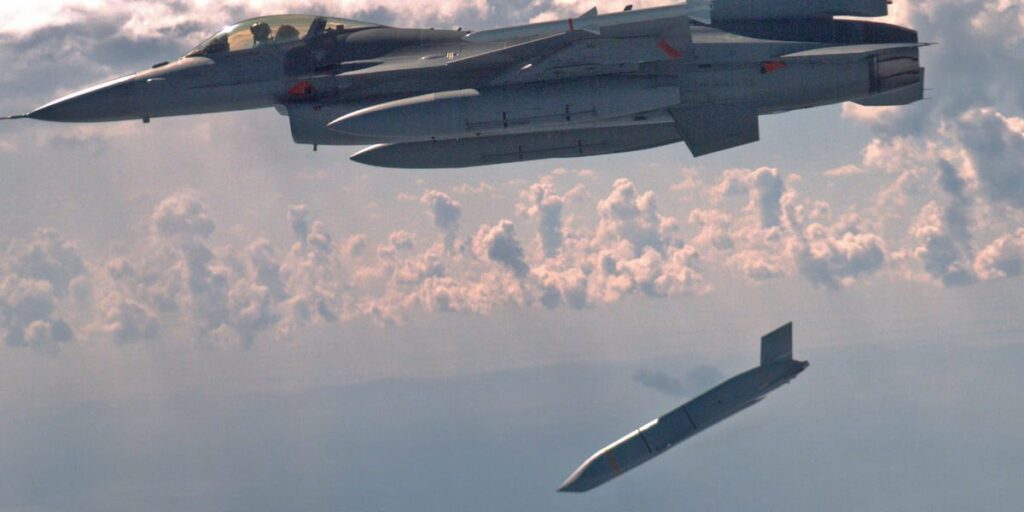The Ukrainian air force’s new F-16 fighter jets could soon be flying with stealthy, American-made long-range cruise missiles.
Recent reports have said that the US is deciding whether to transfer AGM-158 Joint Air-to-Surface Standoff Missiles, or JASSMs, to Ukraine. These high-profile weapons would give Kyiv a significantly farther strike range than any other Western munitions it has in its arsenal.
Beyond whether it will get the weapons, it is also unclear how Ukraine would be allowed to use its JASSMs if it received them. The US could put limitations on its use. As is, it still restricts the country from using its powerful US-provided tactical ballistic missiles to strike military targets inside Russia.
Politico first reported last month that the Biden administration was open to sending JASSMs to Ukraine. Earlier this week, Reuters reported that the US was close to an agreement to send the missiles to Kyiv as part of a weapons package to be announced in the fall, but no final decision has been made yet.
The Pentagon did not respond to Business Insider’s questions about the potential transfer of JASSMs to Ukraine.
JASSMs are low-observable, standoff missiles launched from aircraft to strike surface targets. The American defense firm Lockheed Martin developed them, and they’ve been in service for over two decades, although they only saw combat for the first time a few years ago. Only a small number of countries possess this capability.
Older JASSM variants carry a 1,000-pound warhead and have a range of more than 230 miles, which significantly exceeds that of other Western air-to-surface missiles sent to Ukraine, including the Storm Shadow/SCALP-EG missiles provided by Britain and France.
With that range, JASSMs would also surpass the range of ground-launched US-provided MGM-140 Army Tactical Missile Systems, also known as ATACMS, which have the longest reach of any munition Washington has sent Kyiv so far.
With JASSMs, Ukraine could extend its reach to strike military targets inside Russia. However, the US has prevented Kyiv from using ATACMS to hit Russian territory, and it may do the same with JASSMs, thus limiting their utility to a degree. Targets deep inside the Russian-occupied Crimean peninsula could be fair game, though, as Washington has been more permissive there.
Ukrainian officials have repeatedly lobbied the US to drop all remaining restrictions on striking inside Russia, arguing that these limitations effectively hamstring Kyiv’s ability to fight.
Kyiv is already receiving a variety of capable missiles from the West for its new but small inventory of F-16s. These include air-to-air missiles and air-to-surface weapons. But JASSMs would provide the fighter jets with additional long-range strike options that could be beneficial even if their employment is limited to Russian-occupied territory in Ukraine, as ATACMS are.
Former American fighter pilots said that the weapons would be of great use to Ukraine.
Mike Torrealday, a retired US Air Force colonel who flew combat operations in the Middle East in the F-16, said that sending Ukraine standoff weapons would give its F-16s the ability to reach targets without entering threat areas, like the space covered by Russian air-defense systems.
Standoff weaponry like the JASSM is “a great asset in any conflict because it lets you strike at the enemy without being exposed” to the surface-to-air missile systems, he told Business Insider.
Vincent Aiello, a former US naval aviator who, in addition to flying Navy jets also flew the F-16 during his career, said JASSMs would give Ukraine “a deep interdiction strike capability” that it could use to threaten Russian bases, forces, and logistics operations.
He told BI that “because the weapon includes stealth and programmable routes, it would be more difficult to defend against, making it that much more of a challenge for Russia.”
Read the full article here
















